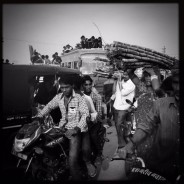
Uso de cookies
Este sitio web utiliza cookies para que usted tenga la mejor experiencia de usuario.
Si continúa navegando está dando su consentimiento para la aceptación de las mencionadas cookies y la aceptación de nuestra política de cookies.


9 December, 2015
As I move on the road a group of trucks going in the opposite direction blink their lights and honk at me to move away from the road. It reminds me of the joke of a driver listening to the radio:
– “Attention! We inform you that there is a car driving in the wrong direction on the motorway. Be aware and be careful.
After hearing the warning, sowing the road and scared, the driver says:
– “A car? It’s all of them!”
In India, you drive on the left; but that’s just the theory. In practice, you drive through anywhere and in whichever way you like. The only way of travelling and surviving in this traffic is to understand that there is no logic; that everything appears to be some form of organised chaos and you ought to accept it, become part of it and continue.
Indian roads are a spectacle of a varied parade of vehicles. It reminds of the film Mad Max: anything with wheels and an engine will do the job. Also, the load limits are not ruled by any physics or universe rules; motorbikes with 7 passengers and trucks with a load that looks like a nuclear bomb mushroom cloud.
Roads are not only for cars, but they also take: cows, monkeys, trucks, buses, 4×4 pickups, cars, tractors, motorcycles, auto-rickshaws, tuk-tuks and, lastly, pedestrians (listed here in the order of respect they receive) Pedestrians ought to have a brain capable of innumerable calculations of distance, speed and trajectory by the way they cross from one side of the Fast roads to the other, sometimes close to suicide.
It looks as well as if, in India, brakes have been replaced by horns. Drivers prefer to deliver a honk concert as they approach so you can get out of their way. India is a very big country. Distances are not measured in kilometres, but in the time it takes to travel them. This has made me rethink the way I can travel here and I’ve decided to travel the North and North West and, like some countries before, I would be missing some bits to visit.
I rather have less places to be in and be able to visit them and travel through them properly than to be locked in a race for kilometres. On other news, my crossing to Thailand through Burma will depend on the grouping of other travellers, since the cost of crossing on my own will be very high. I’m gathering a group to cross it on the 2nd of February. I will make a post with all the details once I’m finished.
So, at the moment I am in Rajasthan, land of the Maharajas and forts, of elephants and camels, of asphalt, marble and desert. I’ve gone through desert areas during this trip and I’ve come to understand the meaning of the desert and solitude. But in India, with a population of more than 1.24bn people, such a thing does not exist. It is hard to find a place where you don’t find people. It is also hard to not be the centre of attention.
I find Indian people curious by nature, in general. When stopping at a petrol station to refuel or rest somewhere to have a tea, I find myself surrounded by almost everyone that passes by and they ask where do you come from, where are you going and whether they can take a picture with you. This became daily routine.
Being in Jaisalmer, I could have gone to the desert on the bike, but since I’ve never tried riding a camel before, I decided it was the best thing to do. Our group was small. Just three of us; Cristina, a Spanish, Walter, a German and me. We also had our two tour guides, Sarupa and Deria, that also cooked for us.
Sarupa tells us his business plans. He already owns two of the four camels we’re riding on. To increase his business, he’d like to buy a female camel in order to breed more camels and be able to also build a guest house. He tells us he’s never been to school and that he’s been educated by the desert and but he speaks a very acceptable English which he’s learned from working with tourists from the age of seven.
While I listen to him, I think of the thing that most caught my attention and I have it with me since coming to India for the first time some 6 years ago; the acceptance that there are first and second class human beings and, regardless of your qualities and abilities, you have your place in society and that you’ll find it very hard to change it.
On some resting points, Sarupa raises his mobile phone as high as possible on the bushes to get a signal. Our conversations sometimes get interrupted when he receives a call to offer him more tourist trips in the coming days. I’m happy for him.
And so, the night falls, with silence as the only sound and the Milky Way as the roof, I look for shooting stars to ask for wishes.
One of these wishes would be for the drivers in India so they could move slowly like the camels; measuring their every step on sand or stone instead of honking so they can get out of their way.